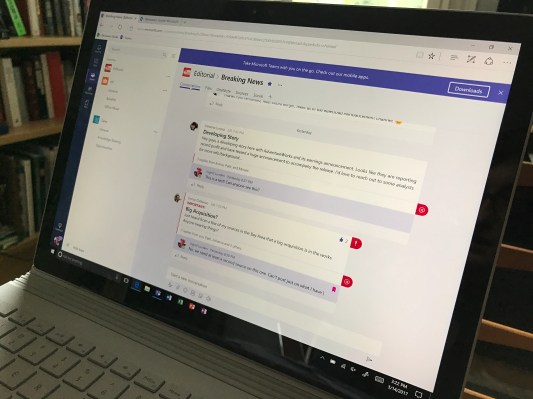After unveiling a limited preview of Teams in November last year, Microsoft is now rolling out its collaboration and communication platform, positioned as a rival to Slack, more widely: Teams is now available, and free, for all 85 million monthly active users of Office 365, Microsoft’s suite of cloud services and apps as a web app and native apps for Windows, iOS and Android.
Along with it, the company is announcing some 150 integrations with third-party services like Asana, Zendesk and Hootsuite, alongside the ability to chat (with other humans or with bots), security services, customization options and more.
(No word on when and whether Teams would expand outside the Office 365 ecosystem: “We’ve had some discussions but right now remain focused on our huge user base,” noted Mira Lane, Microsoft Teams’ UX lead.)
The wider launch comes in the wake of some reasonable success so far. Microsoft said the Teams preview has had some 50,000 organizations sign up and try out the service.
That figure includes both companies that have tried it as well as those who have stayed on to become active users, and Microsoft would only tell me that many stay on, with the number of people per company ranging from small groups to organizations with hundreds of users. (Notable customer wins, it said, include Accenture, Alaska Airlines, Conoco Phillips, Deloitte, Expedia, J.B. Hunt, J. Walter Thompson, Hendrick Motorsports, Trek Bicycle and Three UK.)
For a new app that is coming to the market after the meteoric rise of Slack, as well as other competing services like Workplace from Facebook and Hipchat from Atlassian, some might argue that Teams and Microsoft are late to the game.
In its favor, Microsoft is banking on the low-friction aspect of the service: Those being targeted are already using Microsoft apps like Excel, Word, PowerPoint, OneNote, SharePoint and Power BI, so there will be familiarity and convenience. And it’s free to try out.
As we noted when Microsoft debuted the service in November, Teams throws a lot at the user from the start. If you’ve ever used something like Word or Excel, you know that this is a very Microsoft approach.
The basic interface follows a lot of what you might already know for workplace collaboration products, which are often based around a left rail that lists discussion groups, and the main stream to the right that charts conversations.
Within that, Microsoft takes you into a pretty huge range of different options that tap into its many other products. These include direct chats, the option to hold audio and video calls, the ability to call in spreadsheets and other documents, run some analytics and more, along with spaces for “evergreen” content as well as others for more rapidly changing data.
On top of this, Microsoft has built a chatbot framework that initially is dedicated to helping you use Teams better, but over time will include integrations built by developers to bring in a variety of other services too, similar to Slack, Messenger and a number of other chat services.
This seems to be intentional, not accidental or a sign of disorganization at Microsoft.
“The shift to modern working styles that are open and transparent by default are part of our core philosophy of one size does not fit all,” Lane said in an interview. “Organizations are different in how they do business and collaborate. Some will use multiple tools, for example Yammer for a CEO to speak to the whole organization, but for more tight collaboration they’ll use Microsoft Teams. We think it’s okay to be fluid.”
The strange balance that Microsoft is trying to strike here is between giving you too much to do, too many options; but also the lingering question of whether all this will be enough to sway users to the service.
This is not just an issue when considering Microsoft Teams compared to products from different companies, but when comparing it to Microsoft itself, which already has a number of applications where users can communicate and collaborate with each other, including Yammer, Skype and more.
So far, the experience has been that while some services have definitely gained traction (Slack now has more than 5 million daily active users, and 1.5 million paid accounts), given that there are millions more businesses in the world, there is still a lot to play for, and a lot to win. “We’re seeing people kicking the tires on all products and looking for something more enterprise grade,” Lane noted.
